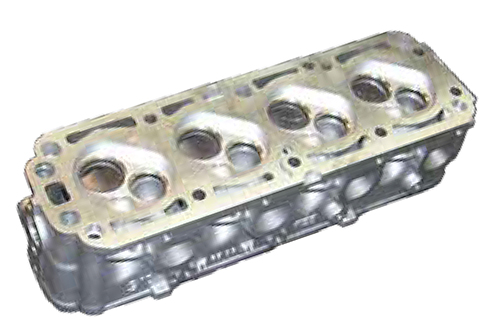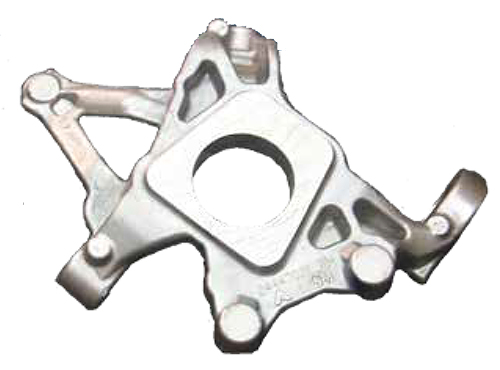|
Search: |
|
Search: |
HOME → ARTICLES → Mold Coatings for Release and Protection

President
CMH Manufacturing Company
www.cmhmfg.com
Permanent mold coating is one of the operational parameters of the casting process that is often overlooked or misunderstood. Permanent mold coatings are necessary for three basic reasons:
With proper use, a permanent mold coating can be used to control the thermal gradients such that directional solidification can be achieved. This allows a pathway for feed metal to flow into the solidifying structure and compensate for normal metal shrinkage during solidification. This is particularly important in castings with thin sections changing to think sections. The thin areas must remain open to ensure that shrinkage will not occur in the adjacent thick section.
In some casting designs there might be two or more characteristics working against one another. For example, a design might have a thinwalled section in need of additional insulation to prolong solidification yet is also in an area that is difficult to release from the mold. In this case a compromise must be reached. By their very nature release coatings are not insulative and insulative coatings will not aid in the release of tight or difficult geometries. In such cases a choice must be made as to which of the two operational characteristics is most important. One choice may be to use a combination coating that will allow for some insulation and some release. Another option is to use an insulating coating as a base coat and a release top coat.
Insulation coatings can vary greatly in insulating qualities as well as the surface finish the coating will impart to the casing. The insulating qualities of a coating are a function of the type of refractory filler that is used and their thermal conductivity and heat capacity. Also contributing to a coating’s insulative capabilities, as well as surface finish, is the amount of binder and the dilution rate. Typically, binders are a sodium silicate. Typical refractory materials found in mold coatings include: vermiculite, bentonite, talc, titanium dioxide, alumina, olivine, and graphite.
Release and chill coatings both contain materials that act as heat conductors to allow for more rapid solidification while protecting the mold against wear. Release coatings typically contain graphite as the lubricant, which is non-wetting by aluminum.

MOLD COATING APPLICATION
As in any coating application, surface preparation is critical. New molds should be thoroughly cleaned. Molds that have been in service must have all the old coatings completely removed. The type of cleaning media used varies and includes sand, metal shot, grit, glass beads and dry ice (CO2). The choice depends on availability as well as how difficult the coating is to remove. In most cases it is recommended the dry ice blasting be used for routine cleaning with periodic sand blasting to restore the mold surface finish for mold coating. Over blasting, especially with sand, shot, or grit, can erode mold detail and shorten mold life.
Mold coatings should be sprayed onto the mold surface with an airless spray gun or an aspiration type spray gun. Spraying equipment may be one of many different styles and types of spray guns. Use of a paint gun is not recommended as the heavy materials in the mold coating easily clog the small ports. A siphon type gun that has one straight fluid tube with replaceable fluid tips works well. Some siphon guns are available with interchangeable pots. With extra pots, two or three different types of coating may be kept on hand, mixed and ready. As the need arises for a particular coating, it may be snapped on the spray head and used immediately.
In areas where a high degree of insulation is required, such as gates, runners, risers and pouring cups, brushing the coating on will provide more insulating capability. In addition to the insulating properties of the coating itself, brushing will trap air bubbles, which enhance insulation. Additionally, the rough surface caused by brushing can aid in molten metal flow through the gating system by continuously disrupting the oxide skin as the metal flows.
Thoroughly mix the coating in its original container before diluting or using only a portion of the can weight. This will alleviate any settling problems that can occur during transit and storage. When diluting, soft warm water works best, but cold water is acceptable. In either case, adequate mixing with any equipment such as a Lighting mixer or a bent rod in a hand drill is required. Excessive shear should be avoided.
The mold should be heated to 600°F (315°C). Care must be taken to heat the mold uniformly. Optical pyrometers should be used to determine if the mold is heating evenly. While the mold is hot it should be sprayed lightly with water. This will increase a porous oxide film on the mold, which will provide a good surface for the mold coating to bond to. The water spray also cools the mold to the desired coating application temperature, 350° - 400°F (75° - 200°C). If the molds are too hot, the rapid expanding water vapor front moving away from the mold will cause a phenomenon known as “kick back,” and very little coating will adhere to the mold. Even the coating that does adhere will not be properly bonded. If the mold is too cold the coating might run resulting in an uneven surface.

Depending on the brand of coating, a primer coat may be required. This could be a specifically designed primer or a diluted version of the main coating. The purpose of the primer coat is to create the best possible adherence of the coating to the mold. This occurs because very diluted sodium silicate solutions allow for bonds that are more parallel to the mold face. This structure forms a stronger bond, which is more resistant to wear. In contrast, high sodium silicate solutions create bonds that are perpendicular to the mold face and can be sheared off. Care must be taken not to over dilute the primer coating, as sufficient sodium silicate must be present to generate the bond. Once the primer is applied, the main coating can be applied at higher concentrations. Do not try to cover the mold face with one heavy coating. A gradual buildup of the coating is preferred over one heavy coat. The number of coats and the exact coating thickness will vary with the casting design and may vary within the mold itself. A working profile should be developed for where a heavier or thinner application of coating should be applied to aid solidification. After the coating has cured, excess coating should be removed from the parting line and core prints with a wire brush or soft brass scraper. As noted, most all commercial mold coating materials are bonded by sodium silicate with various filler materials for their insulative, lubricative or cosmetic qualities.
STORAGE
Mold coating is supplied in fivegallon cans or fifty-five-gallon drums. The coatings should be stored in their original covered containers with the lids firmly in place when not in use. Mold coating should be stored in a dry place away from excessive heat or cold or drastic temperature change. Ideal storage temperatures range from 50°- 75°F (10°- 25°C). Under no circumstances should the coating material be allowed to freeze, as subsequent thawing may not restore the coating to its original condition. Refer to the coating manufacturer’s instructions for additional storage information.